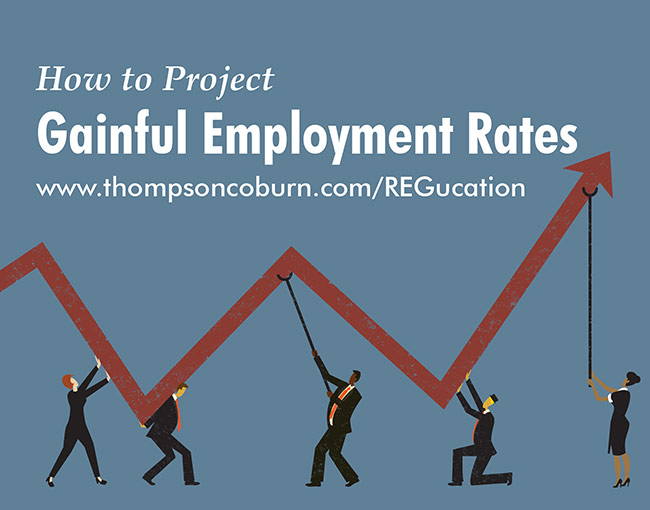As discussed in our previous post, the U.S. Department of Education recently promulgated its new “gainful employment” or “GE” regulations, which prominently feature two metrics intended to assess whether a program offers a reasonable return on investment: (1) the Annual Earnings Rate, and (2) the Discretionary Income Rate. In an effort to assist those institutions interested in projecting “D/E rates,” as these metrics collectively are known, we’re presenting a five-part series that offers step-by-step instructions. The first post in our series covered steps one and two in the process. With this second post we’ll cover steps three and four.
As we indicated in our original post, it’s not possible to project with absolute certainty whether a GE program will produce satisfactory rates (the public does not have access to certain of the data that the Department will use when making its determination for each program). With a few educated assumptions, however, institutions should be able to project which programs will pass easily, which will be close, and which will likely fail.
Step Three: Determining which GE students to include — and exclude — in your cohort
Having identified your OPE ID, and isolated the GE programs offered within that OPE ID (steps one and two in our nine-step process), you now are ready to determine the students who will be included in each GE program’s cohort (i.e., the students for whom you will be analyzing debt and earnings data).
For purposes of calculating D/E rates, the Department defines a “student” as any “individual who received Title IV, HEA program funds for enrolling in the GE program.” 34 C.F.R. 668.402 (Student). Notably, this definition of student includes individuals who received any form of federal financial aid. Thus, for example, a student who received only Pell grants would be included, even if she did not receive any loans. In terms of exclusions, when determining which students to include in your cohort, you will eliminate students who did not receive any Title IV, HEA program funds for enrolling in the program.
In addition, pursuant to section 668.404(e) of the new regulations, you also will need to exclude from your cohort any student satisfying one or more of the following criteria:
- One or more of the student’s Title IV loans were in a military-related deferment status at any time during the calendar year for which earnings information is being gathered (e.g., for the 2014-2015 D/E rates, calendar year 2014);
- One or more of the student’s Title IV loans are under consideration by the Department, or have been approved, for a discharge on the basis of the student’s total and permanent disability;
- The student was enrolled in any other eligible program at the institution or at another institution during the calendar year for which for which earnings information is being gathered;
- For undergraduate GE programs, the student completed a subsequent, higher-credentialed undergraduate GE program at your institution by the end of the most recently completed award year prior to the calculation of your D/E rates;
- For graduate GE programs, the student completed a higher credentialed graduate GE program at the institution subsequent to completing the program by the end of the most recently completed award year prior to the calculation of the your D/ E rates; or
- The student is deceased.
Any student who received Title IV, HEA program funds for enrolling in his or her GE program, and who fails to fall into one of the excluded categories detailed above, would be included in the cohort for the GE program (a “GE Student”).
Step Four: Identifying the applicable cohort period
The D/E rates for each GE program are based on the debt and earnings data for GE Students who completed the program during the applicable cohort period. Accordingly, in order to finalize the student cohort for each GE program, you will need to determine whether to use a two-year cohort period or a four-year cohort period (the only two options). The process is “relatively” straightforward.
The Department defines the two-year cohort period as the period covering the two consecutive award years that are the third and fourth award years prior to the award year for which your D/ E rates are being calculated. A four-year cohort period, in turn, is defined as the third, fourth, fifth, and sixth award years prior to the award year for which your D/E rates are calculated. Pursuant to the new regulations, the Department uses the two-year cohort period when the number of GE Students completing the program is 30 or more, and the four- year cohort period when the number of GE Students completing the program in the two-year cohort period is less than 30 and the number of GE Students completing the program in the four-year cohort period is 30 or more. 34 C.F.R. 668.402 (Cohort Period).
By way of example, let’s assume that we are projecting accountability rates for the 2014-2015 award year (the first award year for which the Department will calculate rates). If after applying all the exclusions discussed in step three, 30 or more GE Students completed the GE program during award years 2010–2011 and 2011–2012, then the 2010–2011 and 2011–2012 award years represent the applicable, two-year cohort period for the program. If, however, at least 30 GE Students did not complete the GE program during award years 2010–2011 and 2011–2012, then you will have to expand the cohort period for the program to include the following four award years: 2008–2009, 2009–2010, 2010–2011, and 2011–2012.
If, after applying all exclusions, 30 or more GE Students did not complete the program over the expanded four-year cohort period, the Department will not calculate D/E rates for the program for the 2014-2015 award year. 34 C.F.R. 668.404(f)(1). However, for purposes of this projection exercise, we suggest that you simply proceed with the four-year cohort, with the understanding that projecting rates based on a 25-student cohort is better than not projecting them at all.
More on cohort size
Before concluding this post, there are a couple of additional points we should address that relate to cohort size.
First, if the Department does not calculate or issue D/E rates for a GE program because the program’s expanded cohort has fewer than 30 GE students, it does not mean that the program passes the rate thresholds established in the new regulations. Rather, the GE program receives a “no result” for that award year and remains in the same status as in the previous award year, when rates were calculated. 34 C.F.R. 668.403(c)(5). Commenting on this provision, the Department offered the following insight in the preamble to the final regulations:
- “For example, where a program receives its first failing result and the institution is required to give student warnings as a result, the program will still be considered to be a first time failing program and the institution will continue to be required to give student warnings in the next award year even if the program’s next D/ E rates are not calculated or issued because it did not meet the minimum n- size requirement.”
79 Fed. Reg. 64928 (October 31, 2014).
Importantly, the “no result” year would not constitute the program’s second year of failure, and thus render the program ineligible. Rather, the Department makes explicit that the program would “still be considered to be a first time failing program.” Also of note, if the Department does not calculate D/E rates for a GE program for four or more consecutive award years, it will disregard the program’s D/E rates for any award year prior to the four-year period when determining the program’s eligibility. 34 C.F.R. 668.403(c)(5).
Second, in certain circumstances, the Department will calculate “transitional rates” using a different cohort period. Pursuant to the new regulations, a GE program failing to satisfy the requisite rate thresholds will be deemed a “failing” or “zone” program. For a period, the Department will calculate for such programs a set of alternative, “transitional” D/E rates, in addition to the standard rates (the period ranges from five to seven award years following the first year the Department calculates D/E rates, and varies depending on program length). 34 C.F.R. 668.404(g).
The transitional rates will be calculated using the standard methodology described in this five-part series, except that the Department will use the median loan debt only of the students who completed the program during the most recently completed award year, instead of the median loan debt of all students who completed the program during the applicable cohort period. The Department would then assess the program’s compliance using the lower of the standard or transitional D/E rates. 34 C.F.R. 668.404(g).
Thus, if you would like to calculate transitional D/E rates for a GE program, you can follow all of the steps described in our series, with one exception: limit your student cohort to GE Students who completed the program during the most recently completed award year.
Our next post will resume with Step Five: Determining each GE Student’s loan debt.
Looking for more information on the new Gainful Employment rules?
For a complete overview of the new gainful employment rules, including reporting, certification, and disclosure requirements, we invite you to listen in to our free gainful employment webinar series. Our next webinar, “Projecting Debt-to-Earnings Rates,” will take place Tuesday, December 9.
Aaron Lacey is a partner in Thompson Coburn’s Higher Education practice, and editorial director of REGucation. You can find Aaron on Twitter (@HigherEdCounsel) and LinkedIn, and reach him at (314) 552-6405 or alacey@thompsoncoburn.com.











